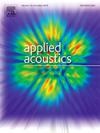Flexural-wave dual bandgaps in elastic metamaterial beam based on L-shaped local resonators
IF 3.4
2区 物理与天体物理
Q1 ACOUSTICS
引用次数: 0
Abstract
For achieving multiple bandgaps, a general strategy is to connect single-degree-of-freedom (DOF) resonators in series to form a unit cell with multiple DOF resonators, thus causing a massive and bulky system. This study proposes an L-shaped local resonator attached to a beam to create multiple bandgaps for achieving broadband vibration isolation by utilizing the higher-order eigenmodes of the local resonator. The theoretical model based on the spectral element method (SEM) is developed to investigate the vibration attenuation property of the metamaterial beam. The theoretical and numerical transmissions of finite-length metamaterial beams are calculated and demonstrated by the experiment. The theoretical, numerical, and experimental results demonstrate that, compared to the conventional strategy, the L-shaped resonator can realize multi-bandgaps as well with lighter mass and smaller dimensions. In addition, we investigated the effects of the structural parameters of the L-shaped local resonator on the bandgap and designed a gradient metamaterial beam to obtain a broader vibration attenuation range by special combinations. The L-shaped local resonator proposed in this paper provides a promising solution for lightweight broadband vibration isolation.
求助全文
约1分钟内获得全文
求助全文
来源期刊

Applied Acoustics
物理-声学
CiteScore
7.40
自引率
11.80%
发文量
618
审稿时长
7.5 months
期刊介绍:
Since its launch in 1968, Applied Acoustics has been publishing high quality research papers providing state-of-the-art coverage of research findings for engineers and scientists involved in applications of acoustics in the widest sense.
Applied Acoustics looks not only at recent developments in the understanding of acoustics but also at ways of exploiting that understanding. The Journal aims to encourage the exchange of practical experience through publication and in so doing creates a fund of technological information that can be used for solving related problems. The presentation of information in graphical or tabular form is especially encouraged. If a report of a mathematical development is a necessary part of a paper it is important to ensure that it is there only as an integral part of a practical solution to a problem and is supported by data. Applied Acoustics encourages the exchange of practical experience in the following ways: • Complete Papers • Short Technical Notes • Review Articles; and thereby provides a wealth of technological information that can be used to solve related problems.
Manuscripts that address all fields of applications of acoustics ranging from medicine and NDT to the environment and buildings are welcome.
 求助内容:
求助内容: 应助结果提醒方式:
应助结果提醒方式:


